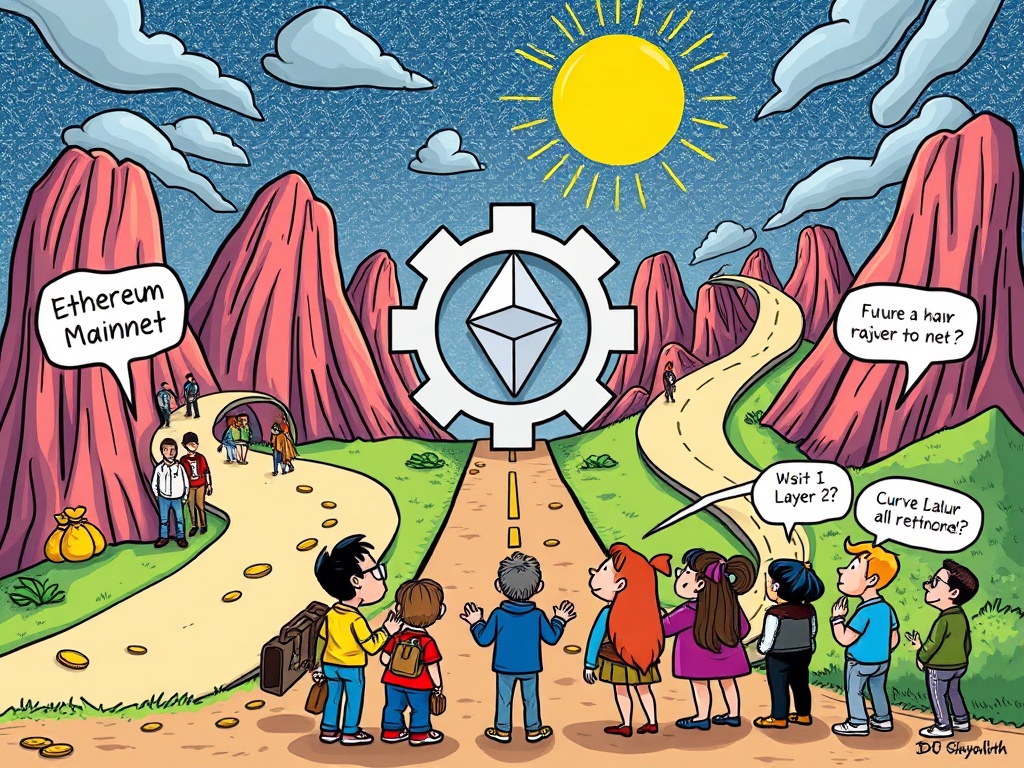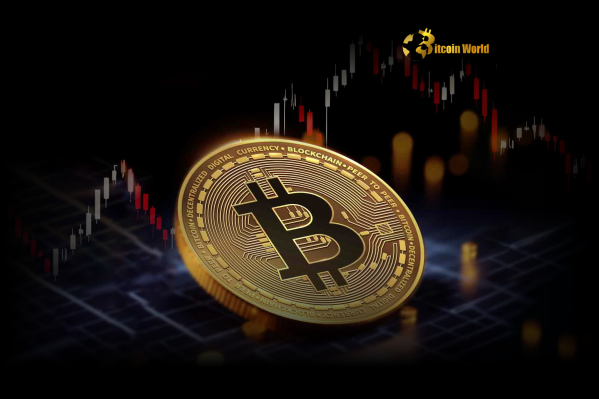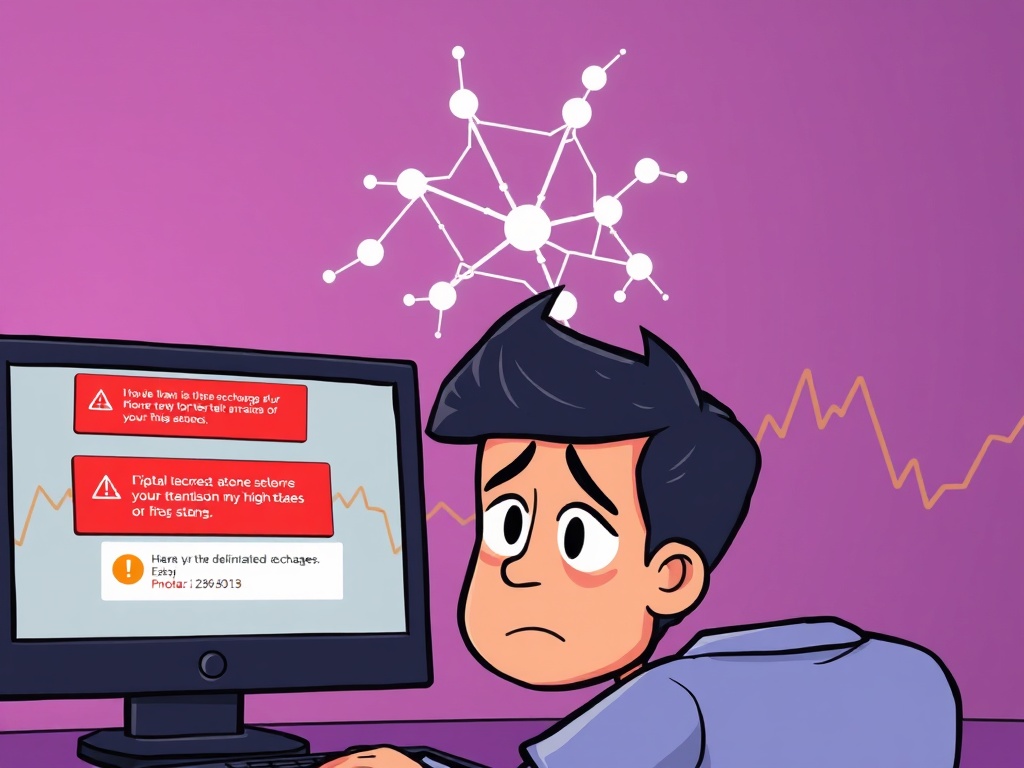BitcoinWorld

Curve DAO Layer-2: A Crucial Rethink of DeFi Strategy
The decentralized finance (DeFi) landscape is a dynamic realm, constantly evolving with new innovations and strategic pivots. At the heart of this evolution are protocols like Curve DAO, a cornerstone of stablecoin liquidity. Recently, a significant discussion has emerged within the Curve DAO community, sparking a crucial rethink of its Curve DAO Layer-2 strategy. This internal debate underscores the complex realities of scaling DeFi and the constant pursuit of efficiency and sustainability.
Why is Curve DAO Now Rethinking its Crucial Layer-2 Strategy?
A pivotal moment for Curve DAO arrived with a proposal from community member “Phil_00LLAMA.” This proposal, detailed in a report by Protos, suggests a significant shift: ceasing further development work on Curve DAO Layer-2 network integrations. The core argument is straightforward yet profound: these Layer-2 deployments are currently generating minimal network fees when compared to the robust activity and fee generation on the Ethereum mainnet.
For a protocol like Curve, which facilitates high-volume, low-margin stablecoin swaps, the economics of operation are paramount. Every integration, every bridge, and every deployment incurs development, maintenance, and opportunity costs. If the return on investment in terms of fees is not substantial, then questions naturally arise about the efficiency of such expansion. This isn’t just a technical discussion about scaling; it’s an economic evaluation of where resources are best allocated to ensure the long-term health and profitability of the Curve DAO ecosystem.
The proposal highlights a growing sentiment among some community members that while Layer-2 solutions offer scalability and lower transaction costs for users, they may not always translate into significant revenue streams for the protocols themselves, especially when liquidity becomes fragmented across many chains. This critical assessment of the Curve DAO Layer-2 approach is a testament to the community-driven nature of decentralized governance, where financial prudence is as important as technological advancement.
Are Curve DAO Layer-2 Integrations Truly Profitable? The Hard Numbers.
The central contention of the proposal revolves around the economic viability of current Curve DAO Layer-2 deployments. While Layer-2s excel at reducing user transaction fees and increasing throughput, the cumulative fees generated for the protocol often pale in comparison to those earned on the Ethereum mainnet. This disparity forces a re-evaluation of the strategic value of spreading liquidity across multiple chains.
To illustrate this point, consider a simplified comparison of hypothetical fee generation:
| Parameter | Ethereum Mainnet | Typical Layer-2 (e.g., Optimism/Arbitrum) |
|---|---|---|
| Transaction Volume (Hypothetical Daily) | High | Moderate to High |
| Protocol Fee per Swap | Standard Curve Fee | Standard Curve Fee |
| Gas Costs (User Perspective) | High | Low |
| Cumulative Protocol Fees (Hypothetical) | Significant | Relatively Lower |
| Liquidity Concentration | High | Fragmented |
This table highlights that while Layer-2s reduce user costs, the aggregate revenue for the protocol might not be as lucrative as maintaining a strong presence on the mainnet. The operational overhead of supporting multiple deployments, including bridge maintenance, security audits, and community support across different chains, adds to the cost. This rigorous financial scrutiny is essential for any decentralized autonomous organization aiming for long-term sustainability and growth in its Curve DAO Layer-2 strategy.
What Happens Next? The Wider Impact of Curve DAO Layer-2 Decisions.
Should the Curve DAO community vote to scale back its Curve DAO Layer-2 expansion, the implications would ripple throughout the DeFi ecosystem. Firstly, for Curve DAO itself, this could mean a more concentrated revenue stream, potentially leading to increased efficiency in its treasury management and a clearer focus on its core operations on the Ethereum mainnet. It could also free up development resources to focus on other strategic initiatives, such as new product offerings or mainnet optimizations.
For existing Layer-2 networks like Optimism, Arbitrum, and Polygon, a major protocol like Curve rethinking its strategy could prompt their own re-evaluations. These L2s strive to attract leading DeFi protocols to bolster their ecosystems, liquidity, and user base. A reduced commitment from Curve might necessitate new incentives or different approaches to attract and retain other flagship projects. It could also influence how other protocols perceive the long-term economic benefits of deploying on various Layer-2s.
From a user perspective, a shift in Curve DAO Layer-2 strategy could lead to a greater centralization of liquidity on the mainnet. While this might mean higher gas fees for some transactions, it could also result in deeper liquidity pools and potentially better swap rates due to less fragmentation. It’s a trade-off between accessibility and efficiency, and the community’s decision will ultimately shape this balance.
This development also sets a significant precedent for the broader DeFi space. As more protocols mature, they will inevitably face similar questions about the economic sustainability of their multi-chain strategies. Curve DAO’s transparent and community-driven approach to this challenge offers valuable insights into how decentralized organizations can adapt to changing market dynamics and prioritize long-term value creation over rapid, potentially unsustainable, expansion.
Beyond Layer-2: What Are the Strategic Alternatives for Curve DAO?
If the community decides to pull back from extensive Curve DAO Layer-2 integrations, what strategic alternatives could Curve pursue? The debate itself opens doors to innovative thinking and a renewed focus on core strengths. Here are a few potential paths:
- Mainnet Consolidation: Curve could double down on its dominance on the Ethereum mainnet. This involves optimizing existing pools, exploring new stablecoin pairs, and enhancing user experience where the vast majority of its fee generation currently occurs. By concentrating liquidity, Curve could further solidify its position as the premier stablecoin swap platform.
- Selective L2 Engagement: Instead of broad expansion, Curve might adopt a more selective approach to Layer-2s. This could mean focusing only on those L2s that demonstrate significant, sustained user activity and fee generation, or those that offer unique strategic advantages, such as specific institutional partnerships or niche user bases.
- Interoperability Solutions: Rather than native deployments on every L2, Curve could explore more robust cross-chain interoperability solutions that allow liquidity to flow seamlessly without requiring full protocol deployments on each chain. This could reduce operational overhead while still offering users access to diverse liquidity.
- New Product Development: With resources potentially freed from L2 development, Curve DAO could invest in new product lines or features that enhance its core offerings or expand into adjacent DeFi verticals. This could include new types of stablecoin pools, yield-bearing assets, or innovative liquidity solutions.
- Enhanced Governance Mechanisms: The current debate highlights the power of community proposals. Strengthening governance mechanisms to allow for more agile and data-driven decision-making on resource allocation could be another strategic focus. This ensures that the Curve DAO Layer-2 strategy, or any future strategy, remains aligned with community sentiment and economic realities.
These alternatives underscore the adaptive nature of decentralized finance. The ability of a DAO to pivot its strategy based on real-world data and community consensus is a significant strength, ensuring its resilience and long-term relevance in a rapidly evolving market.
A Bold Step for Decentralized Finance
The ongoing discussion within the Curve DAO community regarding its Curve DAO Layer-2 integrations is more than just an internal debate; it’s a critical examination of sustainable growth in the decentralized finance space. By questioning the economic viability of broad Layer-2 expansion, Curve DAO is taking a bold step towards prioritizing efficiency and revenue generation over mere presence across multiple chains. This strategic pivot, driven by community consensus and grounded in financial reality, could redefine how leading protocols approach multi-chain expansion. It serves as a powerful reminder that in the world of DeFi, adaptation, rigorous economic analysis, and decentralized governance are key to navigating the complexities of a constantly evolving landscape. The outcome of this proposal will undoubtedly influence the future direction of Curve DAO and provide valuable lessons for the entire blockchain ecosystem.
Frequently Asked Questions (FAQs)
What is Curve DAO?
Curve DAO is the decentralized autonomous organization governing the Curve Finance protocol. Curve Finance is a leading decentralized exchange (DEX) primarily focused on efficient stablecoin swaps and other pegged assets, known for its deep liquidity and low slippage.
What are Layer-2 networks in the context of DeFi?
Layer-2 networks are scaling solutions built on top of a blockchain (like Ethereum) to increase transaction throughput and reduce gas fees. They process transactions off the mainnet but periodically submit proofs back to the mainnet for security and finality. Examples include Optimism, Arbitrum, and Polygon.
Why is Curve DAO reconsidering its Layer-2 integrations?
Curve DAO is reconsidering its Layer-2 integrations primarily because a community proposal argues that these deployments generate minimal network fees for the protocol compared to the Ethereum mainnet, making their continued development and maintenance economically inefficient.
What is the significance of network fees for DeFi protocols like Curve?
Network fees are crucial for DeFi protocols as they often constitute a primary revenue stream. These fees can be used to fund operations, reward liquidity providers, or buy back and burn native tokens, contributing to the protocol’s sustainability and value proposition.
How might a change in Curve DAO Layer-2 strategy impact DeFi users?
A shift could lead to more concentrated liquidity on the Ethereum mainnet, potentially offering deeper pools and better swap rates there. However, it might also mean higher gas fees for users who prefer to transact on Layer-2s, depending on how Curve adjusts its presence on various chains.
What role do community proposals play in DAOs?
Community proposals are fundamental to the governance of Decentralized Autonomous Organizations (DAOs). They allow token holders to suggest, debate, and vote on significant changes to the protocol’s operations, treasury management, and strategic direction, ensuring decentralized decision-making.
Did you find this deep dive into Curve DAO’s strategic considerations insightful? Share this article on your social media to help spread awareness about the evolving landscape of DeFi and the crucial decisions shaping its future!
To learn more about the latest crypto market trends, explore our article on key developments shaping Ethereum price market.
This post Curve DAO Layer-2: A Crucial Rethink of DeFi Strategy first appeared on BitcoinWorld and is written by Editorial Team





